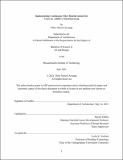Implementing Continuous Fiber Reinforcement for Concrete Additive Manufacturing
Author(s)
Nelson-Arzuaga, Chloe
DownloadThesis PDF (12.57Mb)
Advisor
Tibbits, Skylar
Terms of use
Metadata
Show full item recordAbstract
Concrete additive manufacturing is a promising alternative to standard concrete construction, but the inability to print reinforcement as part of the manufacturing process is a significant limitation. This thesis proposes a method of extruding continuous fiber reinforcement during the 3D printing process. Reinforcement is important in the process of creating concrete structures because while concrete is strong in compression, it has almost no tensile capacity. Reinforcement compensates for this by introducing a high-tensile strength material such as steel rod into the concrete to give it tensile properties.
Current methods of reinforcing concrete 3D printing mainly consists of manually adding rebar into cavities created during the printing process (Mechtcherine et al., 2018). Since the rebar has to be cast into place by hand, many of the benefits of having an autonomous process are reduced. This project designed an extruder for a continuous strand of Kevlar to be extruded alongside the concrete extrusion. Through controlling the speed at which the Kevlar extruder was linearly translated, different densities of Kevlar were created within two layers of concrete. These reinforced concrete pieces were then tested against a similar, but unreinforced piece. The results of this test showed an increase in the residual strength of the concrete as the density of Kevlar was increased. This proves the validity of Kevlar as a reinforcing material and could lead to a more flexible method of adding reinforcement to 3D printed concrete.
Date issued
2021-06Department
Massachusetts Institute of Technology. Department of ArchitecturePublisher
Massachusetts Institute of Technology